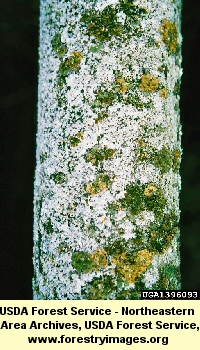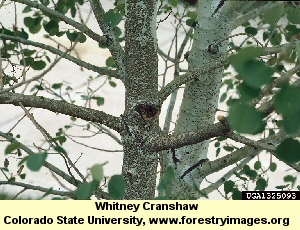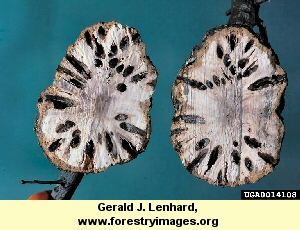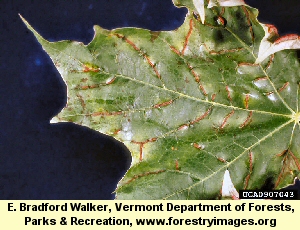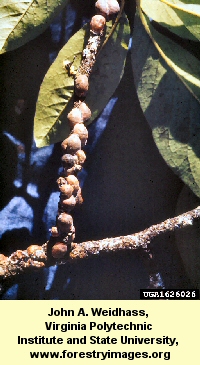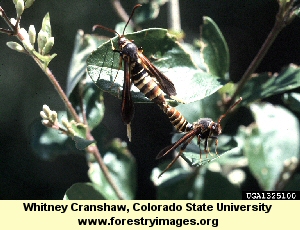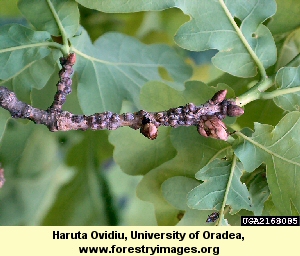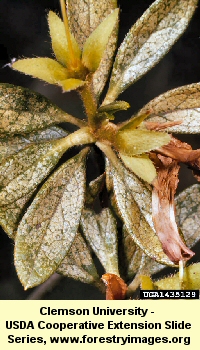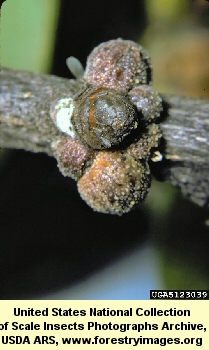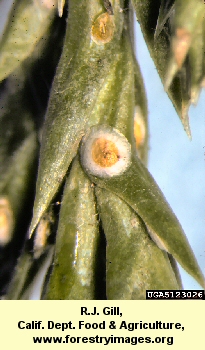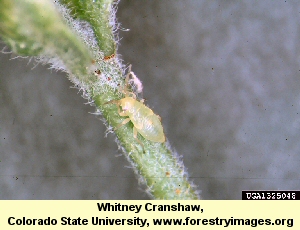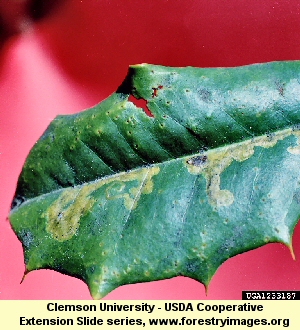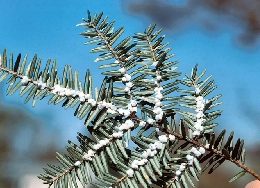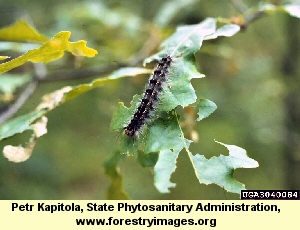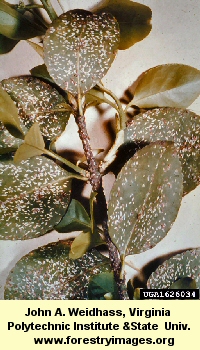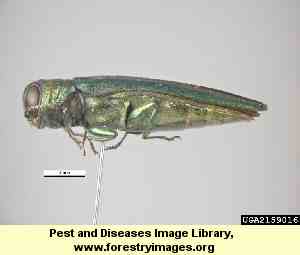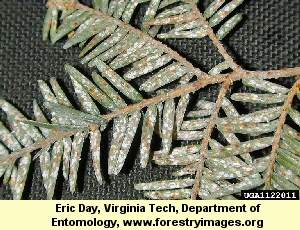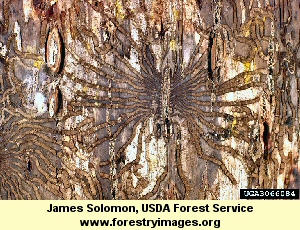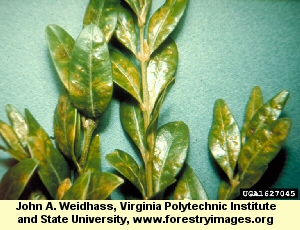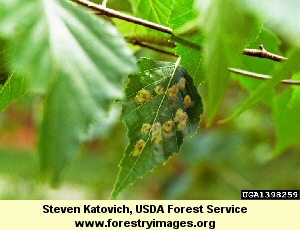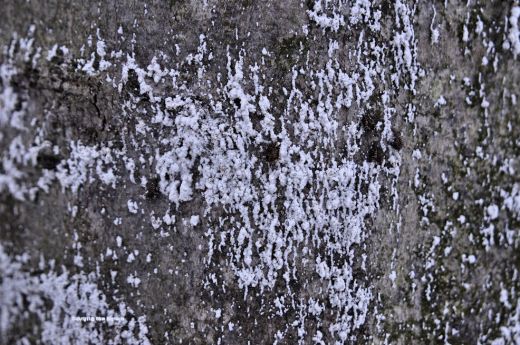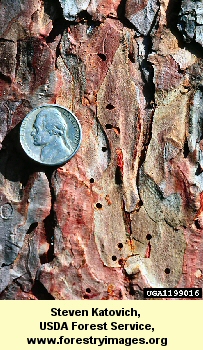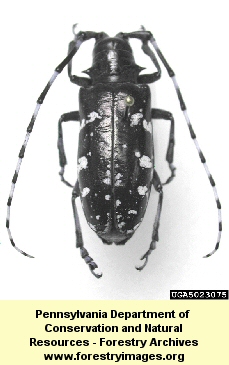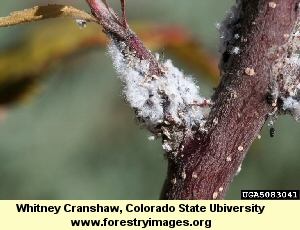Insect Information
Fox Tree Service treats for pests which damage evergreens and deciduous trees throughout Long Island.
Tree & Ornamental Insect Treatment
A wide variety of insects attack trees and ornamentals in our landscape and can cause considerable damage, sometimes in a very short period of time. It can be a devastating experience to watch your beloved trees as they become defoliated by caterpillars, die from the top down due to bark borers, or have their leaves and needles suddenly turn yellow due to leaf-mining insects.
Insects such as Gypsy Moth larvae, Black Turpentine Beetle borers, Ambrosia Beetles, Hemlock Woolly Adelgid, White Prunicola Scale, Euonymus Scale, Japanese Beetles, Bronze Birch Borers and many others can weaken trees to the point that they never recover. Many of these insects have been brought from other countries and have no natural predators. Diagnosis, timing and proper treatment are the solution to outbreaks on your property.
At Fox Tree, we specialize in Integrated Pest Management, a practice which allows us to target specific pests at the correct time in their life cycle and to use the correct materials to eradicate them. This is an environmentally friendly technique which allows the trees and landscape to recover quickly. Whenever possible, we also use reduced risk (organic) materials in order to protect the population of beneficial insects, such as bees, earthworms, ladybugs and other predatory insects which help maintain our ecology. We can also remediate cultural issues such as poor soil conditions, nutrient deficiencies, compaction and other problems.
It is important to establish a plant health care program that includes proper diagnosis and gets the right treatment on at the right time.
This is where Fox Tree comes in.
At Fox Tree Service we will:
- Diagnose and evaluate insect problems throughout your landscape to determine correct treatment.
- Schedule and implement a proper treatment program for individual trees and ornamentals as needed.
- Implement proper preventive techniques in order to stop future outbreaks.
Browse through our pictures below to see if you can identify any of these insect problems in your trees and ornamentals. Please feel free to contact our team of specialists.
Pine Bark Adelgid
Insect Items
Pine bark adelgid is one of the most commonly reported insect pests of pines in America. It feeds on tree trunks by sucking sap from the phloem tissues. If trees are healthy, permanent damage should not result. Damage to older trees is purely aesthetic, but newly planted trees can be seriously injured by the pine bark adelgid, with heavy infestations stunting plant growth. The white woolly filaments, secreted by the insects for their protection, can give the appearance that the [...]
Oystershell Scale
Insect Items
Bark infesting scale insect which can form heavy infestations that causes weak, unthrifty plants and dead foliage. Pruning and spray treatments recommended.
Oak Gall Wasps
Insect Items
There are a variety of gall-forming species of small wasps that commonly infest oak trees in our area. Most leaf galls on oak cause little or no harm to the health of a tree. However, twig or branch galls may cause injury or even death to a heavily infested tree. Two common species of twig gall-producing insects are the horned oak gall wasp and the gouty oak gall wasp. The horned oak gall wasp attacks the twigs of pin, scrub, [...]
Maple Gall Mites
Insect Items
The upper surface of silver and red maple leaves often become covered with small, red, round wart-like structures caused by a small mite, Vasates quadripedes. The structures are generally noticed first in May, about the time the leaves have become fully expanded. At first the galls are green but they quickly turn pink to red and eventually black. Leaves frequently become so covered with the galls that they completely twist out of shape and may even drop early. On sugar [...]
Magnolia Scale
Insect Items
Magnolia scale is one of the largest scale insects we encounter. These scales are usually massed on the undersides of 1 and 2 year old twigs, with heavy infestations completely encrusting branches. Other indicators of a scale infestation include reduced foliage and flower production, undersized leaves and twigs, and honeydew and sooty mold on the foliage. Spray treatments are very effective at the crawler stage.
Lilac Borer & Ash Borer
Insect Items
A bark-boring insect, the ash borer, also known as the lilac borer, belongs to a group of insects known as clear-winged moths. The larvae burrow into wood and cause damage. Newly infested plants can be distinguished by the frass which is pushed out of the burrows by the larvae. Stressed plants are prone to attack. Branch dieback is the main symptom. Bark treatments and soil drenches are suggested.
Lecanium Scale
Insect Items
Oak Lecanium Scale A large scale insect that is seen in quantity attached to twigs and branches. The most common of these is the European fruit lecanium scale. These scales suck the sap from leaves during late July and August and from twigs during May and June of the following year. The young scales collectively produce a great quantity of honeydew, which in turn causes sooty mold to form on the tree and on cars, etc. underneath. If [...]
Lace Bugs
Insect Items
Lace Bug Nymphs Piercing-sucking insect that causes stippled, yellowish to silverish leaves with brownish black "varnish" spots on undersides. Damage is most severe on plants in full sun. Heavily damaged leaves become blanched and yellowish grey and may drop from the plant. This often results in some dieback of twigs and branches and a reduction in flowering the following spring. Spray treatments recommended.
Kermes Scale
Insect Items
Kermes Scale A large scale insect, similar in appearance to lecanium scales, that attacks the twigs of certain oak trees such as red oak. Infestation can cause the branch tips of oak trees to drop off. Adults are rounded and tan-colored. They look similar to buds or other plant growth. Heavy infestations cause "flagging", where the leaves on branch tips turn off-color, droop and often drop off. Infested trees have reduced growth and vigor. Eggs hatch in September [...]
Juniper Scale
Insect Items
Juniper Scale Minute scale insect that feeds on twigs and needles causing yellow foliage which becomes brown in severe infestations. Spray treatments recommended.
Japanese Beetle
Insect Items
Japanese Beetle Adult A brilliant, metallic beetle that feeds on leaves and foliage. They are leaf skeletonizers, that is, they eat the leaf tissue between the leaf veins but leave the veins behind. Attacked leaves look like lace that soon withers and dies. The adults will often attack flower buds and fruit. The grubs can kill small seedling plants but most commonly damage turf. The turf first appears off-color as if under water stress. The turf feels spongy [...]
Imported Willow Leaf Beetle
Insect Items
Imported Willow Leaf Beetle Damage Adults are oval, stout, metallic, greenish-blue beetles which make noticeable holes through the leaves. They first appear in mid-May and are present off and on throughout the summer. Larvae hatch, feed together in rows, and remove only the leaf surface to leave a skeleton of leaf veins. Skeletonized leaves become brown. Larvae are jet black; tiny at first but when full grown are 1/4 inch long. More than one generation occurs. Winter hibernation [...]
Honeylocust Plant Bug
Insect Items
Honeylocust Plant Bug Damage A leaf-feeding insect that exclusively attacks honeylocusts. It easily escapes detection because the color of the nymph and adult closely matches that of new plant growth. If the infestation is extensive, complete defoliation can occur. Both the nymph and adult feed on the foliage of the plant, although the most serious damage is caused by the nymph, early in the season. Damage includes severe leaf distortion, discoloration and dwarfed leaflets. Severe defoliation [...]
Holly Leafminer & Native Holly Leafminer
Insect Items
Holly Leafminer Leaf-mining insect that attacks various holly species. The larvae feed so slowly that the damage may initially go unnoticed. At first, damage appears as a dark brown spot on the leaf, but as further feeding occurs, this turns into a long blotch by late winter. A heavy infestation may result in the majority of leaves being mined. Prior to egg laying, the adult female stabs the leaf with her ovipositor and both male and female adults [...]
Hemlock Woolly Adelgid
Insect Items
Hemlock Woolly Adelgid Hemlock woolly adelgid is a small aphid-like insect from Japan that has become a serious pest of eastern hemlock in the eastern United States. Even though an adelgid is smaller than a period at the end of this sentence, it is easily recognized on the young hemlock twigs by the presence of a dry, white woolly substance that covers its body and its egg masses. Birds, squirrels and deer are important dispersal agents, because the [...]
Gypsy Moth Caterpillar
Insect Items
Gypsy Moth Caterpillar The gypsy moth caterpillar is the single most important insect pest of forest and shade trees in the eastern United States. The larval or caterpillar stage frequently strips entire trees. Severe defoliation can weaken trees, leaving them more susceptible to other stresses, such as drought, disease, and some other, lethal-insect pests such as borers. Trees that are already weakened may be killed. They feed on leaves of more than 300 species of trees and shrubs. [...]
Euonymus Scale
Insect Items
Euonymus Scale This is the most common and most serious pest found on euonymus. The protective armor covering of an adult female euonymus scale is dark, oyster-shaped and about 1/16th inch in length. Adult males are very small, winged insects that leave their narrow, white armored covering for mating. The eggs laid by the female are yellow and found beneath the female’s covering. When the eggs hatch, the crawlers (immature forms) move around before forming their own protective [...]
Emerald Ash Borer
Insect Items
Emerald Ash Borer Recently diagnosed, invasive species which can rapidly kill even the healthiest ash tree. It is estimated that it has already killed over sixty million ash trees in the United States already. The insect is one of the class of metallic wood-boring beetles. The main symptoms of an infested tree are branch die back, sprouting around the base of the tree, and unusual woodpecker activity. Other signs include d-shaped exit holes and if the bark is [...]
Elongate Hemlock Scale & Hemlock Scale
Insect Items
Elongate Hemlock Scale Armored scales that injure host plants by inserting their threadlike, piercing-sucking mouthparts into needles and withdrawing vital nutrients necessary for plant growth from mesophyll cells. Armored scale insects do not feed on the contents of vascular cells. Excessive loss of plant fluid reduces the growth and health of the plant. Feeding injury causes needles to develop yellow banding on the top of infested needles. This injury causes needles to drop prematurely giving the crown [...]
Elm Bark Beetle
Insect Items
Elm Bark Beetle Galleries A bark-boring insect whose main effect on the tree is the transmission of Dutch elm disease. There are two species of elm bark beetles. However, both of these species are important solely for their ability to inadvertently vector (transmit) Dutch elm disease to healthy susceptible elms. The smaller European elm bark beetle is far more aggressive, and therefore more successful, at colonizing weakened elms. They often virtually exclude the native elm bark beetle from [...]
Black Vine Weevil
Insect Items
A common pest of rhododendrons and azaleas. Damage occurs from larvae damaging roots and root crown of plants, and from adult weevils causing notched leaves. Spray treatments recommended.
Boxwood Leafminer
Insect Items
Boxwood Leafminer Leaf-mining insect that causes yellowish mines, mainly noticeable on underside of leaves. Causes plants to become unthrifty and weakened and removes any aesthetic value. Soil treatments are usually most effective.
Black Turpentine Beetle
Insect Items
Black Turpentine Beetle Pitch Tubes Bark-boring beetle that attacks various species but mainly Japanese black pines and pitch pines. The insect brings with it the blue stain fungus (Leptographium spp) which actually causes the decline and death of the trees. Symptoms include "pitch tubes" on lower 6 foot of trunk, off-color needles which turn from light green to brown as areas of tree die off. Bark spray treatments recommended.
Birch Leafminer
Insect Items
Birch Leafminer Damage Leaf-mining insect that attacks newly formed leaves. Some species of birch are resistant, such as River birches or Heritage birches. Symptoms start with dark green spots on leaves which expand into blotch mines covering up to half the leaf. Spray and/ or soil treatments recommended.
Beech Scale
Insect Items
Scale insect that attacks bark of beech trees and can cause decline and death of tree. This insect must be treated if diagnosed. Causes discolored bark and can be seen as white dusting on bark or white woolly masses in crevices. Spray treatments recommended and very effective.
Bark Beetles
Insect Items
A variety of bark-boring beetles can attack weakened or stressed trees. The most commonly known are the ips or pine engraver beetle. Usually, trees are older, have had root areas damaged, or are severely drought-stressed. Spray treatments recommended.
Bagworm
Insect Items
Needle-feeding insect that can cause sparse foliage. Easily diagnosed from spindle-shaped bags attached to twigs and foliage. Attacks a variety of conifers, primarily arborvitae but also spruces and junipers. Spray and/ or soil treatments recommended
Asian Longhorned Beetle
Insect Items
Asian Longhorned Beetle Larva Asian Longhorned Beetle Entry Holes The single biggest threat to hardwood trees in the United States at this time. Attacks mature hardwood trees of all types. Spray treatments and trunk injections are not effective. Infested trees have to be destroyed by law and areas quarantined to stop the spread of the beetle. Has been found in New Jersey, New York and Chicago.
Arborvitae Leafminer
Insect Items
Arborvitae Leafminer The most common insect problem for arborvitae in the north east: a needle-mining insect that affects the outer growth of arborvitae, causing the tips, shoots and foliage to turn yellow and then brown. Spray and/ or soil treatments are both effective.
Apple Maggot
Insect Items
Fruit-damaging insect which attacks fruit at several stages, causing tunnels and pitted skin, and rendering fruit unsuitable for consumption. Spray treatments recommended.
Aphids
Insect Items
Apple Aphid Aphids are common, persistent, and sometimes troublesome pests of trees. Feeding by aphids can stunt plant growth, deform leaves and fruit, or cause galls on leaves, stems and even roots. Aphids also excrete a sugar-containing substance known as “honeydew." We recommend spray treatrments for this insect

